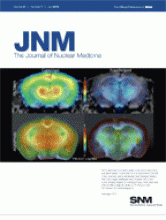REPLY: We would like to thank Nguyen and colleagues for their letter and the 3 questions they have raised after reading our paper (1): first, why the positive predictive value is higher at the 3- and 6-mo scans than at 9 and 12 mo; second, how the false-positive findings relate to the time of occurrence; and third, what clinical information we can present about the false-positive finding illustrated in Figure 2 of our paper.
Regarding the first question, we described a decline in positive predictive value during the 4 PET scans. The general impression of Nguyen et al. is that the false-positive rate declines with the interval between the end of therapy and PET and that such a decline would be associated with an increase in positive predictive value and accuracy. However, in their argument, they neglect the fact that the positive predictive value is dependent on the prevalence of malignancy. Despite a rather constant false-positive rate for the PET scans (9, 9, 10, and 7 for the 3-, 6-, 9-, and 12-mo posttreatment scans, respectively; Table 6 of our article), the positive predictive value decreased because the number of true-positive findings decreased. Patients with a malignancy detected by PET did not undergo subsequent scans.
However, we understand the surprise of Nguyen et al., who expected a decline in false-positive rate with the interval between the end of therapy and PET. They state 2 arguments. First, the accuracy of PET increases with the interval between the end of therapy and PET. We agree, because possible therapy sequelae could interfere with PET. However, this impression is valid only for a relevant period after treatment (3–4 mo). Therefore, we performed the first PET scan 3 mo after treatment (Discussion, paragraph 2, of our article). Our results suggest that PET 3 mo after treatment is not influenced significantly by posttreatment effects because no significant differences existed in sensitivity and specificity. Second, Nguyen et al. state that the results of previous clinical examinations, radiographic imaging, and PET scans would help to improve the confidence and accuracy of the later PET interpretations, 9 or 12 mo after therapy. In a clinical situation, this is correct. However, because of the design of our study, the nuclear medicine physicians could not neglect the focal hot spots in the study if no explanation (e.g., a benign finding) could be found for the uptake. They scored these hot spots as malignant until proven otherwise (as we discussed in our article), probably resulting in a higher rate of false-positive results than would occur in a clinical situation.
Regarding the second question of Nguyen et al., about how false-positive findings related to the time of occurrence, we could not demonstrate a pattern although we had expected to find one.
Regarding the third question, asking for clinical information on the false-positive finding illustrated in our Figure 2, that figure is an example of a false-positive finding that was unexplained by any anatomic substrate. The patient had a T4N2c squamous cell carcinoma of the left maxillary tuber treated with a combination of surgery and radiotherapy. The false-positive hot spot on the subsequent PET scans was indeed located contralaterally. A contralateral malignancy is rare. However, under our protocol the nuclear medicine physicians were not allowed to neglect the high focal 18F-FDG uptake and scored it as malignant. Through our methodology, we tried to create a worst-case scenario in the follow-up and thus accepted a higher chance of false-positives. The scan 6 mo after treatment showed higher 18F-FDG uptake than the scan 3 mo after treatment. The scan 9 mo after treatment showed 18F-FDG uptake equal in size and intensity, but a new focus of uptake was seen at level 5 on the right side. Finally, the scan 12 mo after treatment showed uptake that had increased in size and intensity, and new focal uptake was seen right sublingually. Although the study results suggested malignancy, clinically this uptake was interpreted as physiologic. Additional diagnostics never proved malignancy.
Footnotes
-
COPYRIGHT © 2010 by the Society of Nuclear Medicine, Inc.
References
- 1.↵







